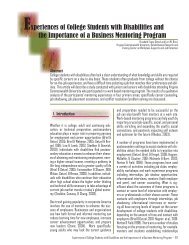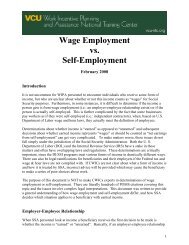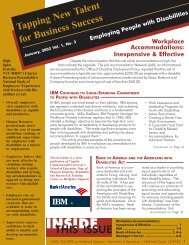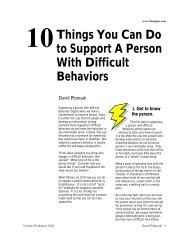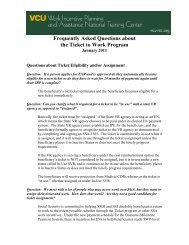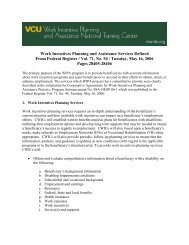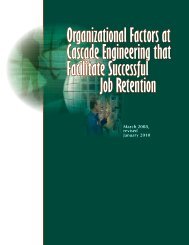114 C.M. Schall / PBS: <strong>Support<strong>in</strong>g</strong> <strong>adults</strong> <strong>with</strong> ASD <strong>in</strong> <strong>the</strong> workplaceior. The true success of <strong>the</strong> plan was that DJ’s job wasmore secure after than prior to <strong>the</strong> implementation ofPBS.4. Directions for future researchThis paper has reviewed <strong>the</strong> research on employmentcharacteristics and supports for persons <strong>with</strong> ASD,described <strong>the</strong> PBS approach, and presented a case todemonstrate <strong>the</strong> application of PBS at work. Despite<strong>the</strong> f<strong>in</strong>d<strong>in</strong>g that PBS is an evidence-based practice for<strong>in</strong>dividuals <strong>with</strong> ASD, <strong>the</strong>re is little research confirm<strong>in</strong>gthat f<strong>in</strong>d<strong>in</strong>g <strong>in</strong> workplace sett<strong>in</strong>gs [7, 34]. Given<strong>the</strong> challenges that <strong>in</strong>dividuals <strong>with</strong> ASD confront atwork, research<strong>in</strong>g <strong>the</strong> implementation of PBS at workis a critical research priority. There are many questionsthat arise <strong>in</strong> this context. First, I proposed thatassess<strong>in</strong>g behavior and implement<strong>in</strong>g positive behaviorsupports <strong>in</strong> <strong>the</strong> workplace may present challengesthat could <strong>in</strong>terfere <strong>with</strong> <strong>the</strong> daily operation of <strong>the</strong> bus<strong>in</strong>ess.Thus <strong>the</strong> first question is; what assessments andwhat types of work supports are most likely to <strong>in</strong>creasesuccess <strong>in</strong> <strong>the</strong> work place <strong>with</strong>out disruption? Second,what array of supports will lead to <strong>in</strong>dependence, orbetter said, <strong>in</strong>terdependence at work? It is unreasonableto expect employers to implement highly stylizedbehavioral <strong>in</strong>terventions, thus <strong>the</strong> concept of contextualfit is an important one [1]. What are <strong>the</strong> types of assessments,<strong>in</strong>terventions, and data collection proceduresthat are most acceptable to employers? Individuals <strong>with</strong>ASD have demonstrated an <strong>in</strong>creased need for <strong>in</strong>tensityacross <strong>the</strong>ir lifespan, from early childhood throughadulthood. Yet, <strong>the</strong> availability of supports dim<strong>in</strong>ishesgreatly <strong>in</strong> adulthood. Therefore, from a policy perspective,what services are necessary to prepare and support<strong>in</strong>dividuals <strong>with</strong> ASD at work? F<strong>in</strong>ally, what work supportmodels result <strong>in</strong> <strong>the</strong> highest level of successfulplacement for <strong>in</strong>dividuals <strong>with</strong> ASD?Most <strong>adults</strong> <strong>with</strong>out disabilities def<strong>in</strong>e <strong>the</strong>mselves by<strong>the</strong>ir work. Work is, arguably one of <strong>the</strong> most importantendeavors <strong>in</strong> which humans engage. Yet, researchregard<strong>in</strong>g <strong>in</strong>dividuals <strong>with</strong> ASD has largely focusedon supports for toddlers and young children between<strong>the</strong> ages of three to six [21]. Clearly, it is a priority toidentify <strong>the</strong> skills and supports necessary to <strong>in</strong>crease<strong>in</strong>dividuals <strong>with</strong> ASD’s participation <strong>in</strong> employment.As demonstrated through out <strong>the</strong> school life of childrenand youth <strong>with</strong> ASD, PBS is a highly successful <strong>in</strong>terventionthat results <strong>in</strong> significant reductions <strong>in</strong> problembehavior [7]. There is every reason to believe that PBSwill play an important role <strong>in</strong> <strong>the</strong> adult work lives of<strong>in</strong>dividuals <strong>with</strong> ASD.References[1] R.W. Alb<strong>in</strong>, J.M. Lucyshyn, R.H. Horner and K.B. Flannery,Contextual fit for behavioral support plan: A model for goodnessof fit, <strong>in</strong>: Positive Behavior Support: Includ<strong>in</strong>g People<strong>with</strong> Difficult Behavior <strong>in</strong> <strong>the</strong> Community, L.K. Koegel, R.L.Koegel and G. Dunlap, eds, Brookes, Baltimore, 1996.[2] L.M. Bambara and L. Kern, Individualized Supports for Students<strong>with</strong> Problem Behaviors: Design<strong>in</strong>g Positive BehaviorPlans, Guilford <strong>Press</strong>, New York, 2005.[3] L.M. Bambara and T.P. Knoster, Design<strong>in</strong>g Positive BehaviorSupport Plans (2nd ed.), American Association on MentalRetardation, Wash<strong>in</strong>gton, DC, 2009.[4] S. Bell<strong>in</strong>i and J. Akullian, A meta-analysis of video model<strong>in</strong>gand video self-model<strong>in</strong>g <strong>in</strong>terventions for children and adolescents<strong>with</strong> <strong>autism</strong> <strong>spectrum</strong> <strong>disorders</strong>, Exceptional Children 73(2007), 264–287.[5] E. Billstedt, C. Gillberg and C. Gillberg, Autism after adolescence:Population-based 13–22 year follow-up study of 120<strong>in</strong>dividuals <strong>with</strong> <strong>autism</strong> diagnosis <strong>in</strong> childhood, Journal ofAutism and Developmental Disorders 35 (2005), 351–360.[6] E.G. Carr, G. Dunlap, R.H. Horner, A.P. Turnbull, W. Sailor,J.L. Anderson, R.W. Alb<strong>in</strong>, L.K. Koegel and L. Fox, Positivebehavior support: Evolution of an applied science. Journal ofPositive Behavior Interventions 4 (2002), 4–16.[7] E.G. Carr, R.H. Horner, A.P. Turnbull, J.G. Marquis, D.M.McLaughl<strong>in</strong>, M.L McAtee, C.E. Smith, K.A. Ryan, M.B. Ruef,A. Doolabh and D. Braddock, Positive Behavior Support forPeople <strong>with</strong> Developmental Disabilities: A Research Syn<strong>the</strong>sis,AAMR, Wash<strong>in</strong>gton, DC, 1999.[8] E.G. Carr, L. Lev<strong>in</strong>, G. McConnachie, J.I. Carlson, D.C. Kempand C.E. Smith, Communication-Based Intervention for ProblemBehavior: A User’s Guide for Produc<strong>in</strong>g Positive Change,Brookes, Baltimore, 1995.[9] M. Cederlund, B. Hagberg, E. Billstedt, I.C. Gillberg andC. Gillberg, Asperger syndrome and <strong>autism</strong>: A comparativelongitud<strong>in</strong>al follow-up study more than 5 years after orig<strong>in</strong>aldiagnosis. Journal of Autism and Developmental Disorders 38(2008), 72–85.[10] R.E. Cimera and R.J. Cowan, The costs of services and employmentoutcomes achieved by <strong>adults</strong> <strong>with</strong> <strong>autism</strong> <strong>in</strong> <strong>the</strong> US,Autism 13 (2009), 285–302.[11] L. Crane, L. Goddard and L. Prang, Sensory process<strong>in</strong>g <strong>in</strong><strong>adults</strong> <strong>with</strong> <strong>autism</strong> <strong>spectrum</strong> <strong>disorders</strong>, Autism 13 (2009),215–228.[12] G. Dunlap and E.G. Carr, Positive behavior support and developmentaldisabilities: A summary and analysis of <strong>the</strong> research,<strong>in</strong>: Handbook of Developmental Disabilities, S.L. Odom, R.H.Horner, M.E. Snell and J. Blacher, eds, Guilford <strong>Press</strong>, NewYork, 2007.[13] G. Dunlap, R. Iovannone, C. English, D. K<strong>in</strong>caid, K. Wilson,K. Christiansen and P. Stra<strong>in</strong>, Prevent-Teach-Re<strong>in</strong>force: TheSchool Based Model of Individualized Positive Behavior Support,Brookes, Baltimore, In <strong>Press</strong>.[14] V.M. Durand and E. Merges, Focus on Autism and O<strong>the</strong>r DevelopmentalDisabilities 16 (2001), 110–119.[15] L.C. Eaves and H.H. Ho, Young adult outcome of <strong>autism</strong> <strong>spectrum</strong>disorder, Journal of Autism and Developmental Disorders38 (2008), 739–747.
C.M. Schall / PBS: <strong>Support<strong>in</strong>g</strong> <strong>adults</strong> <strong>with</strong> ASD <strong>in</strong> <strong>the</strong> workplace 115[16] D. Garcia-Villamisar, D. Ross and P. Wehman, Cl<strong>in</strong>ical differentialanalysis of person <strong>with</strong> <strong>autism</strong> <strong>in</strong> a work sett<strong>in</strong>g:A follow-up study, Journal of Vocational Rehabilitation 14(2000), 183–185.[17] F. Gerber, M.A. Baud, M. Giroud and G.G. Carm<strong>in</strong>ati, Qualityof life of <strong>adults</strong> <strong>with</strong> pervasive developmental <strong>disorders</strong> and<strong>in</strong>tellectual disabilities, Journal of Autism and DevelopmentalDisorders 38 (2008), 1654–1665.[18] B.A. Glassberg, Functional Behavior Assessments for People<strong>with</strong> Autism: Mak<strong>in</strong>g Sense of Seem<strong>in</strong>gly Senseless Behavior,Woodb<strong>in</strong>e House, Be<strong>the</strong>sda, MD, 2006.[19] D. Hagner and B.F. Cooney, “I do that for everybody”: Supervis<strong>in</strong>gemployees <strong>with</strong> Autism, Focus on Autism and O<strong>the</strong>rDevelopmental Disabilities 20 (2005), 91–97.[20] M. He<strong>in</strong>eman and G. Dunlap, Factors affect<strong>in</strong>g <strong>the</strong> outcomesof community-based behavioral support: II. Factor categoryimportance, Journal of Positive Behavior Interventions 3(2001), 67–74.[21] D. Hendricks and P. Wehman, The transition from school toadulthood for youth <strong>with</strong> <strong>autism</strong> <strong>spectrum</strong> <strong>disorders</strong>: A reviewand recommendations, Focus on Autism and O<strong>the</strong>r DevelopmentalDisabilities 24 (2009), 77–88.[22] J. H<strong>in</strong>ton, G.B. Mesibov and A.V. Wood, TEACCH-supportedemployment program, Journal of Autism and DevelopmentalDisorders 27 (1997), 3–9.[23] A. Hillier, T. Fish, P. Cloppert and D.Q. Beversdorf, Outcomesof a social and vocational skills support group for adolescentsand young <strong>adults</strong> on <strong>the</strong> <strong>autism</strong> <strong>spectrum</strong>, Focus on Autism andO<strong>the</strong>r Developmental Disabilities 22 (2007), 107–115.[24] R.H. Horner, Positive behavior supports, Focus on Autism andO<strong>the</strong>r Developmental Disabilities 15 (2000), 97–105.[25] P. Howl<strong>in</strong>, J. Alcock and C. Burk<strong>in</strong>, An 8 year follow-up of aspecialist supported employment service for high-ability <strong>adults</strong><strong>with</strong> <strong>autism</strong> or Asperger syndrome, Autism 9 (2005), 533–549.[26] P. Howl<strong>in</strong>, S. Goode, J. Hutton and M. Rutter, Adult outcomefor children <strong>with</strong> <strong>autism</strong>, Journal of Child Psychology andPsychiatry 45 (2004), 212–229.[27] K. Hurlbutt and L. Chalmers, Employment and <strong>adults</strong> <strong>with</strong>Asperger syndrome, Focus on Autism and O<strong>the</strong>r DevelopmentalDisabilities 19 (2004), 215–222.[28] T. Knoster and D. K<strong>in</strong>caid, Long-term supports and ongo<strong>in</strong>gevaluation, <strong>in</strong>: Individualized Supports for Students <strong>with</strong>Problem Behaviors: Design<strong>in</strong>g Positive Behavior Plans,L. Bambara and L. Kern, eds, Guilford <strong>Press</strong>, New York, 2006.[29] L.P. Lattimore, M.B. Parsons and D.H. Reid, Enhanc<strong>in</strong>g jobsite tra<strong>in</strong><strong>in</strong>g of supported workers <strong>with</strong> <strong>autism</strong>: A reemphasison simulation, Journal of Applied Behavior Analysis 39 (2006),91–102.[30] L.P. Lattimore, M.B. Parsons and D.H. Reid, Assess<strong>in</strong>g preferredwork among <strong>adults</strong> <strong>with</strong> <strong>autism</strong> beg<strong>in</strong>n<strong>in</strong>g supportedjobs: Identification of constant and alternat<strong>in</strong>g task preferences,Behavioral Interventions 18 (2003), 161–177.[31] L. Lawer, E. Brusilovskiy, M.S. Salzer and D.S. Mandell, Useof vocational rehabilitative services among <strong>adults</strong> <strong>with</strong> <strong>autism</strong>,Journal of Autism and Developmental Disorders 39 (2009),487–494.[32] J.K. Luiselli, Antecedent Assessment and Intervention: <strong>Support<strong>in</strong>g</strong>Children and Adults <strong>with</strong> Developmental Disabilities<strong>in</strong> Community Sett<strong>in</strong>gs, Brookes, Baltimore, 2006.[33] L. Mawhood and P. Howl<strong>in</strong>, The outcome of a supportedemployment scheme for high-function<strong>in</strong>g <strong>adults</strong> <strong>with</strong> <strong>autism</strong>or asperger syndrome, Autism 3 (1999), 229–254.[34] National Professional Development Center on AutismSpectrum Disorders, Evidence-based Practices for Childrenand Youth <strong>with</strong> ASD, Retrieved August 6, 2009 fromhttp://www.fpg.unc.edu/(<strong>autism</strong>PDC/assets/pdf/ebp flyer1-23-09.pdf, January 23, 2009.[35] S. Nesbitt, Why and why not? Factors <strong>in</strong>fluenc<strong>in</strong>g employmentfor <strong>in</strong>dividuals <strong>with</strong> Asperger syndrome, Autism 4 (2000),357–369.[36] R.E. O’Neill, R.H. Horner, R.W. Alb<strong>in</strong>, J.R. Sprague, K. Storeyand J.S. Newton, Functional Assessment and Program Developmentfor Problem Behavior: A Practical Handbook, (2nded.) Brooks/Cole, Publish<strong>in</strong>g Co., Boston, 1997.[37] P.A. Prelock, Autism Spectrum Disorder: Issues <strong>in</strong> Assessmentand Intervention, Pro-ed, Aust<strong>in</strong>, Tx, 2006.[38] C. Schall, Positive behavior support and functional curriculum:Identify<strong>in</strong>g functional skills through functional behaviorassessment and positive behavior support plann<strong>in</strong>g, <strong>in</strong>: FunctionalCurriculum for Elementary, Middle, and SecondaryAge Students <strong>with</strong> Special Needs, (3rd ed.), P. Wehman andJ. Kregel, eds, Pro-ed, Aust<strong>in</strong>, Tx, In <strong>Press</strong>.[39] C. Schall and J. McFarland-Whisman, Meet<strong>in</strong>g transition goalsthrough <strong>in</strong>clusion, <strong>in</strong>: Autism and <strong>the</strong> Transition to Adulthood:Success Beyond <strong>the</strong> Classroom, P. Wehman, M.D. Smith andC. Schall, eds, Brookes, Baltimore, 2009.[40] C. Schall and P. Wehman, Understand<strong>in</strong>g <strong>the</strong> transition fromschool to adulthood for students <strong>with</strong> <strong>autism</strong>, <strong>in</strong>: Autismand <strong>the</strong> Transition to Adulthood: Success Beyond <strong>the</strong> Classroom,P. Wehman, M.D. Smith and C. Schall, eds, Brookes,Baltimore, 2009.[41] C. Schall, P. Wehman, E. Doval-Cortijo and P. Target, Applicationfor youth <strong>with</strong> <strong>autism</strong> <strong>spectrum</strong> disorder, <strong>in</strong>: Life Beyond<strong>the</strong> Classroom: Transition Strategies for Young People <strong>with</strong>Disabilities, (3rd ed.), P. Wehman, ed., Brookes, Baltimore,2006.[42] J. Schaller and N.K. Yang, Competitive employment for people<strong>with</strong> <strong>autism</strong>: Correlates of successful closure <strong>in</strong> competitiveand supported employment, Rehabilitation Counsel<strong>in</strong>g Bullet<strong>in</strong>49 (2005), 4–16.[43] M.M. Seltzer, M.W. Krauss, P.T. Shattuck, G. Orsmond,A. Swe and C. Lord, The symptoms of <strong>autism</strong> <strong>spectrum</strong> <strong>disorders</strong><strong>in</strong> adolescence and adulthood, Journal of Autism andDevelopmental Disorders 33 (2004), 565–681.[44] M.M. Seltzer, P. Shattuck, L. Abbeduto and J.S. Greenberg,Trajectory of development <strong>in</strong> adolescents and <strong>adults</strong> <strong>with</strong><strong>autism</strong>, Mental Retardation and Developmental DisabilitiesResearch Reviews 10 (2004), 234–247.[45] M.D. Smith, R.G. Belcher and P.D. Juhrs, A Guide to SuccessfulEmployment for Individuals <strong>with</strong> Autism, Paul H. Brookes,Baltimore, 1995.[46] M.D. Smith and D. Coleman, Manag<strong>in</strong>g <strong>the</strong> behavior of <strong>adults</strong><strong>with</strong> <strong>autism</strong> <strong>in</strong> <strong>the</strong> job sett<strong>in</strong>g, Journal of Autism and DevelopmentalDisorders 16 (1987), 145–154.[47] The Partnership for People <strong>with</strong> disabilities, PositiveBehavior Support Facilitator Project, Retrieved August 7,2009 from http://www.vcu.edu/partnership/pbs/pdf/PBS%20facilitator%20<strong>in</strong>formation%20flyer5.pdf, undated.[48] M. Watanabe and P. Sturmey, The effect of choice-mak<strong>in</strong>gopportunities dur<strong>in</strong>g activity schedules on task engagementof <strong>adults</strong> <strong>with</strong> <strong>autism</strong>, Journal of Autism and DevelopmentalDisorders 33 (2003), 535–538.[49] P. Wehman and J. Kregel, Supported competitive employmentfor <strong>in</strong>dividuals <strong>with</strong> <strong>autism</strong> and severe retardation: Two casestudies, Focus on Autistic Behavior 3 (1988), 1–13.[50] P. Wehman, M. Smith and C. Schall, Autism and <strong>the</strong> Transitionto Adulthood: Success Beyond <strong>the</strong> Classroom, Paul H. Brookes,Baltimore, 2009.



